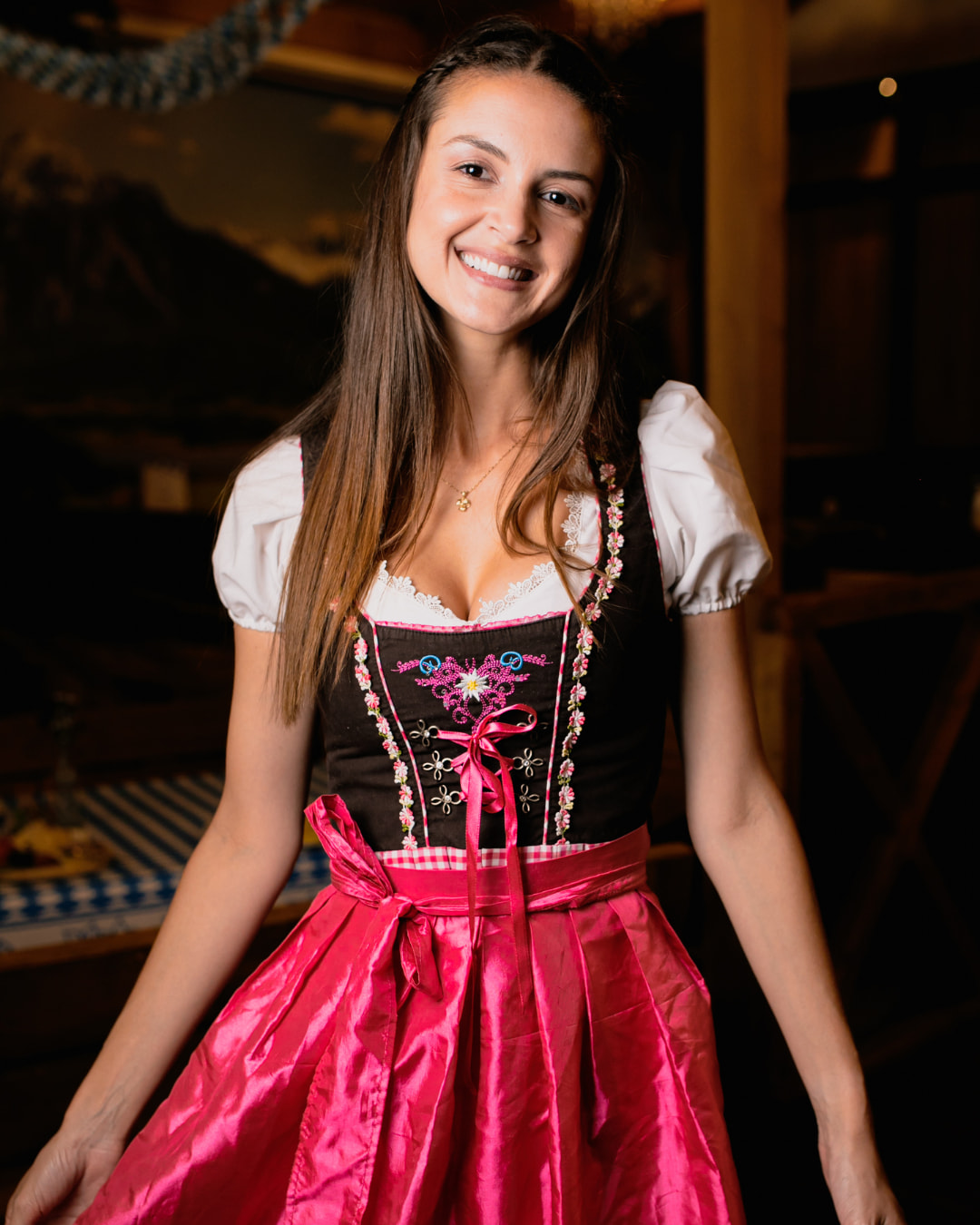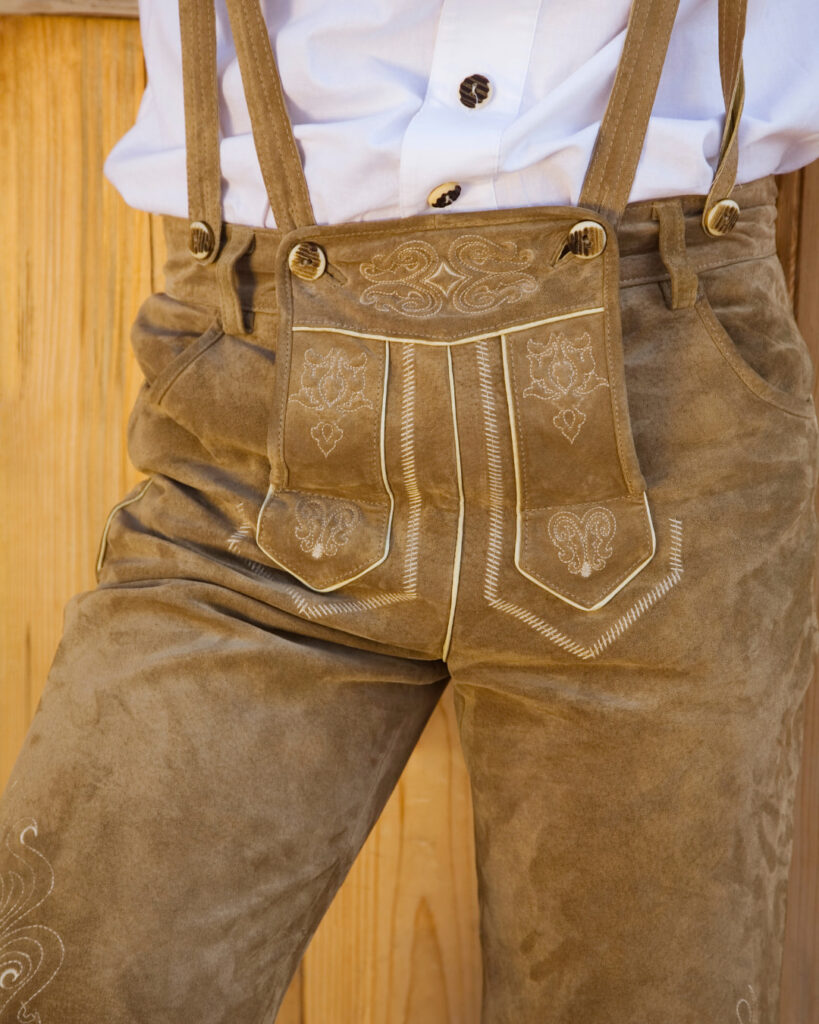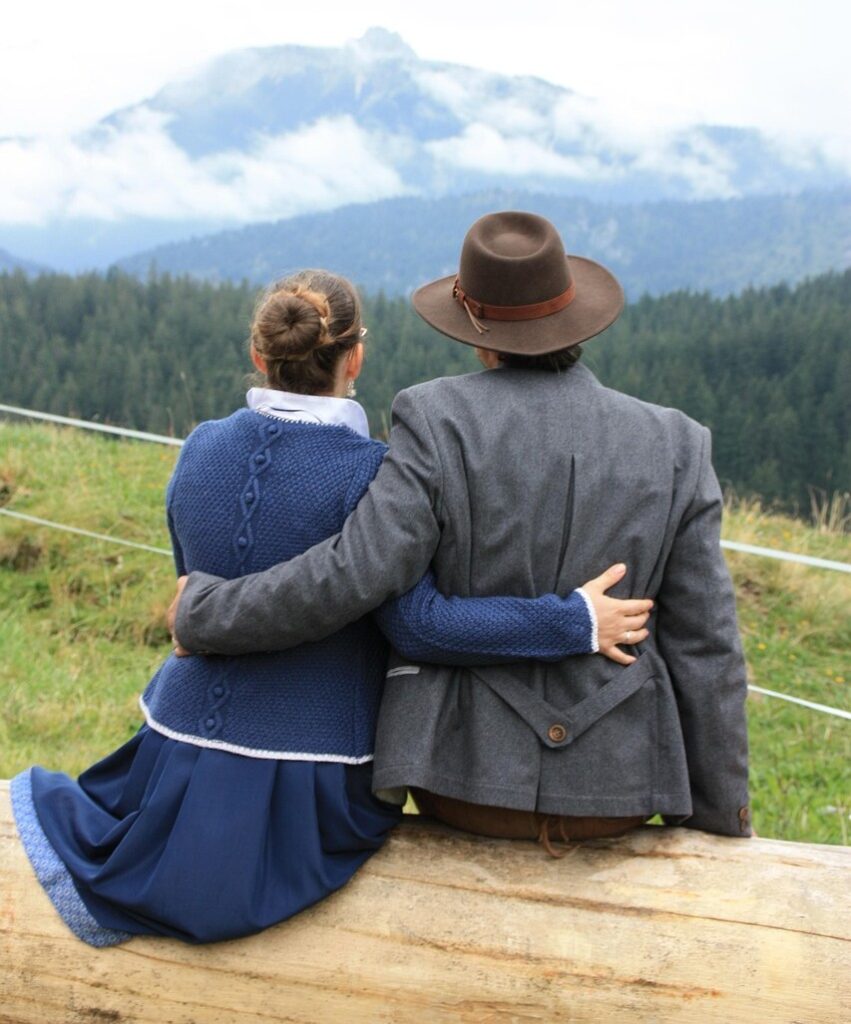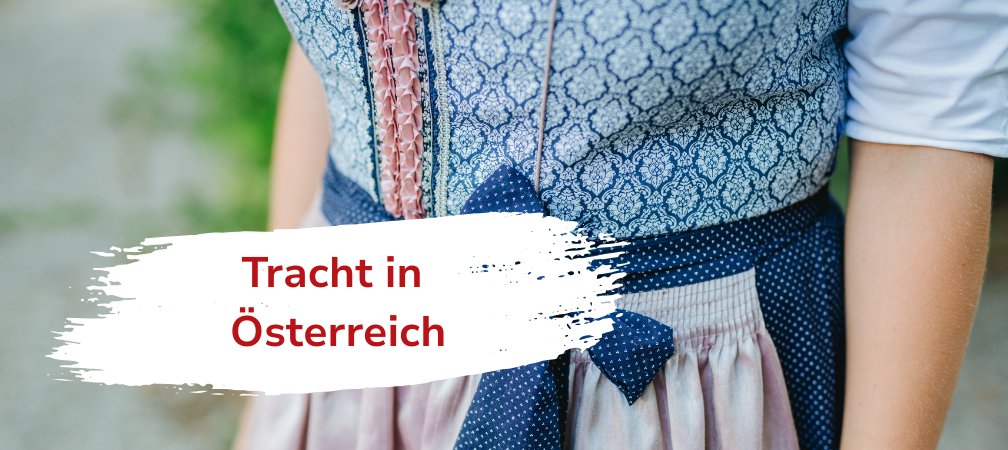The joyous tones of an accordion, happy chatter, a sea of colourful clothes: Whether public festivals, fairs or weddings, Austrian traditional clothing, better known as “Tracht”, is an integral part of Austrian culture – and a lot more than just a simple piece of clothing. With more than 800 different types of Tracht worn across all parts of Austria, it’s a proud symbol of tradition and belonging. Here, we’ll take a closer look at what it’s all about – and why Dirndl, Lederhosen and more are so special.
The Origins of Austria’s Tracht
Although traditional costumes nowadays are synonymous with tradition, cultural identity and a strong fashion sense, they originally used to be worn as regular day-to-day work clothes. As such, they can be traced back all the way to the late middle ages, where they were commonly worn by the people in the country. Even back then, clothes used to tell a lot about the person wearing them: Regional differences and dress codes defined the design and appearance of the clothes, while also indicating the wearer’s social status. So how did Austria’s traditional clothing develop from these origins? Let’s take a look at the history of two of the most famous pieces of clothing: the Dirndl and Lederhosen.
The Austrian Dirndl

The original Dirndl is based around a tried-and-tested, practical concept: a dress (the traditional everyday piece of clothing worn by women up until the 20th century) with an apron on top. As the dress was usually worn over long periods of time, the apron served to protect the dress against the dirt and dust on the field or in the kitchen – also making it possible to quickly wipe one’s hands if necessary, all without dirtying or damaging the dress. Naturally, the apron was also frequently changed.
The Dirndl we’ve come to know and love, however, appeared on the scene much later – in the 1930s, to be precise. As a general trend towards more feminine silhouettes started to emerge in fashion, functionality was ditched in favour of design, paving the way for the transformation of previously basic work clothes into a traditional, yet fashion-forward statement piece. Today, the Dirndl is commonly worn at public festivals and fairs, as well for weddings and church – or a visit to a local Heurigen.
| By the way: The term “Dirndl” itself is derived from an old German word which translates to girl or young woman – a term which is still commonly used to refer to young women in many German-speaking parts of the world. |
Lederhosen

Not many fabrics and materials compare to the impressive history of leather as an integral part of clothes manufacturing. Because of their durability, trousers made from leather were a popular choice amongst men and women when carrying out hard physical labour. Typically, the trousers would be made from hide of domesticated animals, as hunting game used to be exclusively reserved for nobility up until the 19th century. Over time, leather was used less and less for making trousers, and gradually replaced by loden, a heavy wool fabric.
In 1883, a teacher from Bavaria founded the first society for traditional costumes in Bavaria in order to preserve the local dress for future generations. The society wrote a letter to King Ludwig II. pleading for royal support for their cause – with the result that the king himself ordered regional offices and councils in other parts of the country to also establish societies for preserving local tradition. Across the border, the Austrian imperial house quickly picked up on this trend, resulting in Lederhosen being brought back from the brink of extinction and established as a local traditional costume. However, it wasn’t until after WWI and the rise of alpine tourism that it became irrevocably tied to Austria and Bavaria.
| Fun Fact: Emperor Franz Josef I. was a huge fan of Lederhosen – so much so that Salzburg’s famous traditional house Jahn-Markl came up with a new and unique colour design just for him: Old Black. To this day, it’s a very popular and well-loved colour to wear. |
Austrian Tracht today: Merging Trends with Tradition

Although dating back many centuries, Austrian traditional costumes are constantly evolving. Both Dirndl and Lederhosen reflect current fashion styles and trends, with the former being particularly versatile in terms of the colours, designs and accessories available. While long Dirndl dresses were once considered the go-to for elegant occasions, the skirt now tends to hit just below or even above the knee, particularly in casual settings like local festivals and fairs. In Austria, it’s actually quite common to own more than one Dirndl or Lederhosen to be able to choose different outfits depending on the occasion. That being said: Tracht still remains an integral part in everyday life, and is quite frequently worn as a work uniform within the hospitality sector, for example in hotels or restaurants.
In which parts of Austria are traditional costumes worn?
Traditional costumes can be found in all parts of the country, and are usually defined by a very region-specific design that reflects the local history, culture and identity. As such, you’ll see everything from more casual Tracht to opulent festive wear. Let’s take a look at some of the most famous ones:
Bregenzer Juppe (Vorarlberg)
The Bregenzer Wald region in the most western part of Austria is home to the oldest traditional costume in the Alpine region, which is also part of the UNESCO Intangible Cultural Heritage since 2021: the Juppe, a women’s costume dating back as far as the late 15th century. The Juppe is characterised by its intricately crafted skirt with 500 to 600 pleats, worn together with a red or black bodice and a gold-embroidered neckerchief tucked into the neckline. The ensemble is completed with a black patent leather belt featuring a golden buckle, which is positioned right at the centre of the back. For headwear, there are several options: unmarried girls wear a gold tinsel crown – called “Schappale” in Austrian dialect – while a lace cap is worn when attending church.
Gailtaler Tracht (Carinthia)
The Untergailtal women’s festive costume stands out clearly from the otherwise rather dark and demure Carinthian festive attire. It typically consists of a short underskirt and an elaborately crafted, starched skirt made from twelve metres of fabric, paired with a linen blouse featuring puffed sleeves and a V-shape neckline. Two aprons are worn (a small dark one and a large patterned one), along with eye-catching stockings and embroidered lace-up boots. The finishing touch is provided by a silk headscarf, a neckerchief, and a decorated leather belt.
In contrast, the men’s costume is kept relatively simple: a white linen shirt with puffed sleeves and red herringbone stitching on the collar is typically worn with a high-necked waistcoat featuring silver buttons. A colourful silk scarf is tied over the waistcoat. The top is paired with knee-length leather trousers in black or brown, and tall riding boots. The headwear is a wide-brimmed blackfloppy hat with a twisted cord and tassel.
Kalmuckjanker (Lower Austria)
The coarse wool fabric of the Kalmuckjanker from the famous Wachau and Weinviertel regions in Lower Austria boasts an intriguing history: it is said to have been brought to Austria around 1730 by a West Mongolian people as a saddle blanket. Boatmen, rafters, and stonemasons repurposed the durable fabric into jackets that they wore while working. The attire was later adopted by winemakers in the Wachau region. To this day, the Kalmuckjanker is easily recognisable by its distinctive pattern and is usually worn in combination with a white cotton shirt, black trousers, and a black hat adorned with a stone-feather tuft.
Ausseer Tracht (Styria)
The Ausseer men’s costume is defined by the so-called Spenzer – a short jacket made of dark green cloth or grey loden with green trimmings on the collar, sleeves, and pockets. The version commonly worn today, the so-called Hohenlohe-Spenzer, is fastened with two silver buttons and a small silver chain, and is traditionally paired with intricately embroidered leather trousers. The outfit is completed with green, cable-knit wool stockings and a black Ausseer hat, which nowadays is typically decorated with a capercaillie feather, a chamois beard tuft, or a “Radlbart” tuft.
The Ausseer Dirndl consists of a white blouse, a green linen bodice with seven silver buttons, a pink cotton skirt, and a purple apron featuring a delicate floral or striped pattern. To complete the costume, white cotton stockings, a hand-printed silk scarf with fringes, silver jewellery, and a black hat are worn. In cooler weather, the Dirndl is often paired with a Spenzer, while the traditional “Wetterfleck”, a waterproof and sleeveless dark loden cape, is used for rain protection.
How to wear Austrian Tracht?
The numerous regional traditional costumes each follow their own rules, specifying exactly which accessories belong to the traditional attire. In the past, shoes, headwear, and similar items were strictly defined, even for simple Dirndl dresses and Lederhosen. Today, the rules have become significantly more lenient: essentially, anything goes. If you’d like to keep in line with tradition, however, here’s a brief overview of the most classic accessories for Dirndl and Lederhosen.
How to wear Lederhosen
Unlike a Dirndl, Lederhosen should never be washed. Signs of use such as stains, abrasions, and a certain patina are simply part of the look. For an authentic feel, complete your outfit with these accessories:
- a traditional leather shoe with decorative side lacing
- a traditional shirt, usually checked in red, blue, or green
- knitted calf warmers that can be worn with or without socks; traditionally used to cover bare skin
- long knitted socks that come up to just below the knee, worn with short Lederhosen just like knitted calf warmers
- a decorative knife with a wooden or antler handle – arguably the most important Lederhosen accessory (note: a regular pocket knife is an accepted alternative)
- a jacket made of felted sheep’s wool (“Janker”), usually in grey or green, with metal or horn buttons.
How to wear a Dirndl
As is often the case in fashion, ladies have a particularly wide range of shoes, blouses, and jewellery to choose from:
- traditional women’s shoes with a heel, usually made of suede
- a softer and slimmer version of the men’s traditional leather shoe, often featuring a slightly upturned toe
- a blouse – typically available in a wide variety of cuts and styles, ranging from short to long sleeves, and plain to elaborately decorated designs with lace. Most blouses are white, occasionally black
- a traditional necklace, often consisting of short chains or chokers decorated with hearts, pearls, or Alpine motifs – the Edelweiss is a particularly popular one
What does the dirndl symbolise?

Nowadays, everyone can freely choose the colours and style of their traditional costume. But despite all these modern twists on a classic, certain shades are still commonly associated with emotions, regional characteristics of nature, or the colours of local and regional coats of arms.
A red Dirndl, for example, can express passion, love, and self-confidence. Blue represents loyalty and steadfastness, while green symbolises hope and a deep connection to nature – both are classic Dirndl colours. Black, while traditionally worn in mourning, is also a popular and elegant choice for festive occasions. Pink and soft pastel tones, which have become established in recent years on the fashion scene, typically convey playfulness and romance.
Interestingly, the colour of a Dirndl can also often hint at its place of origin: blue for regions with large bodies of water, green for landscapes rich in forests and meadows, pink for the Alpine rose, and deep purple for areas where gentian grows.
| Did you know? You can reveal quite a lot about your relationship status with the bow on the apron: A bow tied on the left indicates a woman is single. Married women will normally tie the bow on the right, while widows traditionally tie their apron at the back. |
Whether simple or elaborate, interpreted with a modern twist or worn strictly in line with traditional rules – Austrian Tracht remains the ultimate fashion symbol of belonging and cultural identity. It connects generations, tells stories, and reflects the unique character of each region. No wonder it’s still proudly worn all over the country.
By the way: You can discover even more fascinating insights into Austria’s people, culture, and traditions on our blog – from our guide to classic Austrian cuisine and famous coffee specialities to the best tips for learning German. And if you’d like to get active yourself, the Österreich Institut offers a wide range of German courses for every language level – both tailored to individuals, groups and companies.

